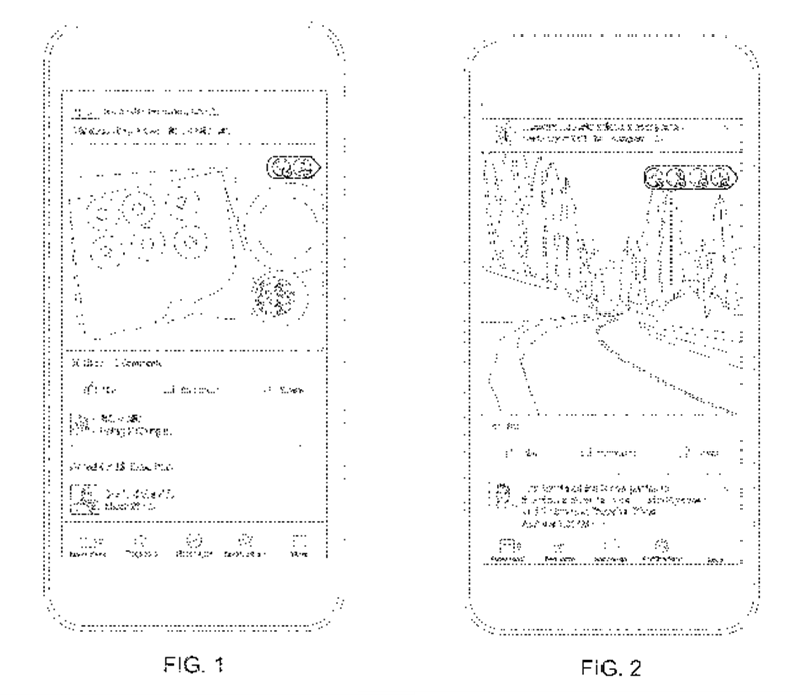U.S. Design Patents for User Interfaces (UI)
In the realm of user interface (UI) design, a fascinating fusion of science and art takes place, creating experiences that are both functional and visually captivating. This interdisciplinary blend shapes the way we interact with technology, from the smooth navigation of a smartphone app to the elegant layout of a website. UI designers harness the principles of human-computer interaction, psychology, and visual aesthetics to craft interfaces that are intuitive and engaging. In this landscape, design patents play a crucial role, protecting the unique visual elements that define a product’s identity. Comparing the brown-box of Amazon with its recognizable black and blue accents to the intricate design of the X app, these patents are a testament to the creative ingenuity and technical precision required to blend the scientific rigor of usability with the artistic flair of graphic design, resulting in user interfaces that not only work seamlessly but also delight and inspire.
Design patents in the United States protect the ornamental design of a functional item, offering a way to safeguard the visual aspects of user interfaces (UIs). Many household brands file hundreds of design patents a year, Nike, Apple, LG Corp, to name a few, and each protects the artistic and ornamental view of its interface. Unlike utility patents, which protect the functional aspects of an invention, design patents focus solely on ornamental design. This is particularly relevant for user interfaces, where the design can significantly influence user experience and brand identity.
What is a Design Patent? In the US a design patent protects the unique visual qualities of a manufactured item for 15 years from the date of the grant. It applies to the ornamental aspects, which include the shape, configuration, and surface ornamentation of an article. For user interfaces, this protection extends to the graphical user interface (GUI) elements displayed on a screen, such as icons, layout arrangements, and animations.
Importance of Design Patents for User Interfaces? User interface designs play a critical role in differentiating products in the market. Protecting these designs through patents ensures that competitors cannot copy the distinctive look and feel of a UI, which can be a significant part of a product’s appeal and usability. Compare the apps on your phone. Each one is uniquely designed to appeal visually, separate from its actual functionality. Why is this important? An aesthetically pleasing design creates a positive impression on the user, one that may lead them to believe the product or design actually works better. Moreover, users are likely more forgiving of minor difficulties if the design of a product or service is more aesthetically pleasing. Perception is crucial, especially in today’s highly competitive market.
Drawings for a UI Design Patent? User Interface design patents are primarily concerned with the visual and ornamental aspects of a UI, such as icons, layout, and screen designs. The drawings and layout for these patents are crucial because they define the scope of the protection.
Line drawings are commonly used for UI design patent applications. This requires the drawings to be clear and precise, as they visually represent the ornamental design being protected. Broken lines, or dashed lines, are often used to show environmental elements or portions of the design that are not claimed as part of the patent. For example, if the patent is for an icon design, the icon itself would be shown in solid lines, while the background or device outline might be depicted with broken lines to indicate that they are not part of the claimed design.
Additionally, multiple views are generally required to fully disclose the design. These may include front view, rear view, perspective views, or top/bottom views.
Another unique aspect of design patents may be the involvement of animations or transitions, such as swipe features or screen transitions. A series of drawings should be included showing the sequence; each drawing in the sequence would illustrate a different stage of the animation or transition to convey the overall visual effect.

USD819058S1 Meta Platforms Inc Design Patent
UI Design Cases? In a world of adaptive technology, the courts are not naïve to copying designs or in the converse, patent holder attempting to broaden the reach of their claim. In proving infringement in a design patent, the claim must survive the “ordinary observer” test laid out in Egyptian Goddess, Inc. v. Swisa, Inc. (2008), where a purchaser would see the design are substantially the same. This comparison of the products are as a whole, rather than specific points or points of novelty. In a recent case, Wepay Glob. Payments LLC v. McDonald’s Corp. (2022), the court compares a rather ordinary design of boxes:
“. . . GUI apps have been around a long time. Plaintiff’s attempt to compare what is essentially nothing but unadorned squares and circles with McDonald’s sales items, food menu, and condiments, might perhaps be good fodder for a Seinfeld episode, but borders on the ridiculous in a federal court.”
Wepay Glob. Payments LLC v. McDonald’s Corp. (2022).
UI Design Patent Takeaways? User interface design patents represent the harmonious convergence of artistic creativity and scientific methodology, encapsulating the essence of what makes a digital experience both functional and aesthetically pleasing. The meticulous process of crafting patent drawings is not merely a formality but a critical element in defining and protecting the unique visual aspects of a UI design. These drawings serve as the definitive representation of the designer’s vision, capturing the subtleties of form, layout, and ornamentation that distinguish one interface from another. Such ideas raise the images of our beloved apps or sleek smartphone designs. By precisely illustrating the ornamental features that are both innovative and functional, the drawings ensure that the design’s originality is recognized and safeguarded. In this way, UI design patents celebrate the ingenuity at the intersection of art and science, underscoring the importance of both disciplines in creating engaging and intuitive digital experiences.
About the blogpost author:
 Marissa Parisek is a 3rd year law student at the University of Alabama (Tuscaloosa) and a summer intern at Wood Intellectual Property Law & Strategy.
Marissa Parisek is a 3rd year law student at the University of Alabama (Tuscaloosa) and a summer intern at Wood Intellectual Property Law & Strategy.

Jon Wood has been a Chief IP Counsel for over 10 years, with over 20 years practicing IP Law in both corporate and law firm settings. He is consistently listed in the IAM Strategy 300 – The Worlds Leading IP Strategists.



